
Undiscovered Angola has amazing potential with its spectacular beach, mountain, savannah and desert scenery as well as its friendly people. A great place to ride your bicycle!
Luanda – Porto Amboim – Benguela – Namibe – Lubango – Namibian Border at St.Clara
July 19th – August 17th, 2022.
1613 km cycled
With Kurt retired and Darina’s unpaid leave approved, there was nothing stopping us. Our one-year Africa adventure has finally become a reality!
We picked Angola as a starting point for two reasons. The first one was climate. Starting in July in the Southern Hemisphere would mean that we would be leaving summer in Europe to hit winter in Africa. However, the closer to the Equator, the milder it would be. The second reason was the visa procedure. Angola is not as open as a tourist would wish and getting a visa before flying made more sense.
With a lovely farewell from the Bähler/Müller family at Zurich airport, we flew with TAP via Lisbon to Luanda, the capital of Angola.


On arrival, there was a very efficient twenty-minute Covid-test procedure, followed by a long queue to get our passport stamped, despite having gone through the motions with the Embassy in Switzerland to obtain an eVisa ahead of time. Of the eighty foreigners (mostly business related) in the queue, there were only six ladies, who were duly pulled out and given a seat while their visas were given priority. Darina emerged two hours after landing; Kurt’s patience was tested for a further two!


Our Couchsurfing host, Luciano, had a van and a taxi waiting outside so we could reassemble our bikes at his place. This was our first time as Couchsurfing guests, and we were pleasantly surprised with the luxurious ensuite room and culinary treats Luciano organised for us at home. We were introduced to many local specialities including Mofete fish, fried plantains, beans and funge (a cassava porridge). Many thanks to Luciano for this warm welcome and introduction to Angola.


The city itself, often referred to as the most expensive city in Africa, is probably not some place you have to see before you die! The Fortress of São Miguel, stemming from Portuguese colonial days, offers a viewpoint of the waterfront lined with palm trees and backed by high rise, 5-star hotels and cranes as far as the eye can see.


On the other side, a sprawling shanty town brings you quickly back down to earth as the huge extremes of wealth and poverty are accentuated. Not far away the luxurious Presidential Palace and National Assembly buildings in characteristic peach tones make it clear where spending gets priority in this oil-rich land.
One building that stands out is the beautiful Palácio de Ferro (Iron Palace) which is home to exhibitions of local artists and sculptors. The origin on this amazing iron building is quite the mystery. Reputedly recovered from a sinking ship in 1890, it had always been associated with Gustav Eiffel of Eiffel Tower fame. That was until recently when an inscription on one of the original iron pieces was discovered and it pointed to a factory in Glasgow, Scotland!

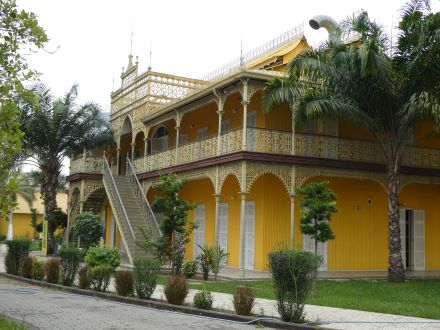
The Portuguese ruled for over 400 years and used Luanda as the centre of their colonial slave trade. When Angola became independent in 1975 a ferocious civil war raged for almost 30 years between the three nationalist groups: MPLA, supported by Cuba and the USSR; UNITA and FNLA supported by South Africa, the US and Zaire (now DRC). Hundreds of thousands were left homeless and up to a million lost their lives. Now twenty years later, the scars of the war are still visible on some buildings, and the country is still recovering and finding itself. The MPLA have been in power ever since.


Leaving this city of 2.7 million, was relatively stress free and it wasn’t long before we spotted the first flamingos and baobab trees. Thumbs up, fist pumps, waves, horns and a chorus of boa viagem and bom dia set the scene as we headed south on the main road: EN100. Friendly local cyclists participating in a time trial-event en route gave us a great send-off confirming their support should anything arise.
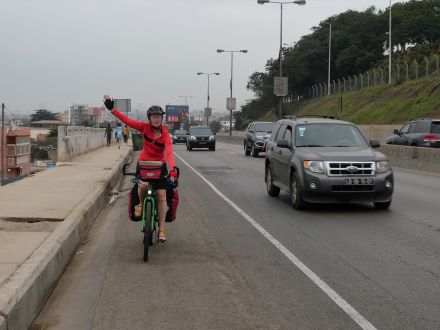

Our first major attraction was also on day one: Miradouro da Lua. This strangely eroded cliff in white, yellow and red really gives the sensation on being in a unique lunar landscape and is definitely the perfect Instagram location 😉


Further south, the EN100 enters the Kissama National Park, which extends for almost 10,000 km2. Poaching and hunting during the civil war left the park stripped of its wildlife, but a Noah’s Ark programme with Botswana and South Africa has restocked the park. While we didn’t have elephants, giraffes or wildebeests greet us, we did have a few families of monkeys and loads of colourful birds among the baobab trees and savannah grasslands.
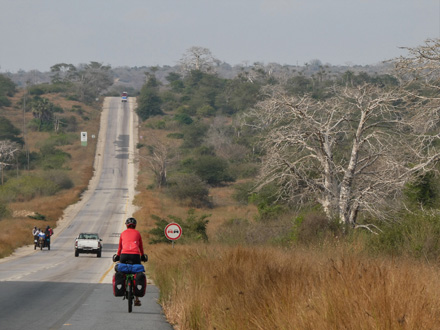

Angola is famous for its beautiful beaches and a side trip down to the coast at Cabo Ledo revealed the contrasting worlds of poverty-stricken fishing villages alongside exclusive tourist resorts. We opted to camp wild on the beach. Being winter and dry season, we were surprised to wake up to a mist the next morning. This is seemingly common along the coast at this time of year.
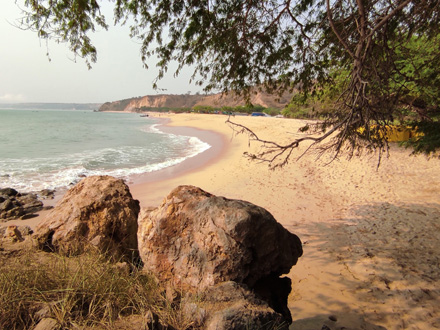

All along the route south, we were greeted by a friendly chorus of “bom diiiiiiiiiia.” The village huts vary in quality often depending on their proximity to a river and the possibility to grow a few vegetables. Most of the villagers we spoke to hadn’t gone to school and spoke their own language making communication beyond the basics quite difficult. In the cities, where Portuguese is widely spoken, we were able to communicate quite well with Spanish.
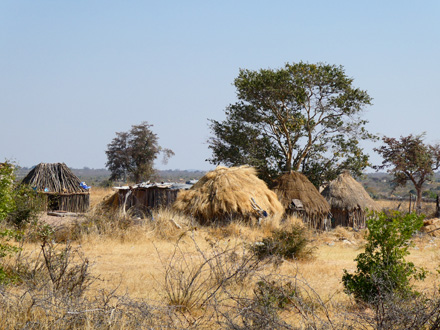

The EN100 road itself is paved, and the potholes tend to slow down the traffic. There was often a hard shoulder and we found Angolan truck drivers to be exceptionally accommodating on the road leaving us loads of space when overtaking. A common sight on the roadside was sacks of charcoal for sale; a cottage industry to make ends meet.


As we reached Sumbe, the traffic increased immensely as the incumbent President João Lourenço was holding a huge rally in town in preparation for the upcoming presidential elections. A well-known African proverb goes: A leader without followers is just a crackpot out for a walk! Well, the MPLA party seems to take this seriously and rounds up coaches and truckloads of followers for such rallies by offering them a t-shirt or baseball cap to join the convoy.


The coastal morning fog continued all the way to Benguela, a former colonial town with some charming colonial buildings and Nancy’s English language school that rents out rooms and offers a chance of interaction with the students.


Leaving Benguela we came upon another time trial race; this time cyclists from the Benguela, Namibe and Lubango regions competing. And yet again, we had a chance to practice our Spanish-Portuguese mix.

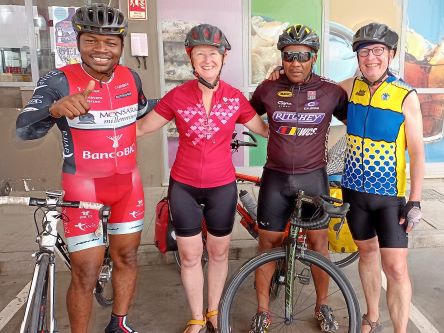
What lay ahead was a remote stretch of road including a 70km gravel section, that resulted in all the traffic taking an alternative shorter route via Lubango. It was also a lot drier and more scenic than anything we had seen further north.


The desert appeared in all hues of red, yellow and white and wherever a river left some water, there was some vegetable farming and the chance of a roadside market.


We met a lot of tribal communities on this route; many with their two front teeth filed to leave an inverted V gap as a sign of beauty. The men were clad in colourful sarongs open on the side and the women were topless. Some wore numerous golden bracelets around their wrists/ankles as a sign of wealth, although the whole area seemed to be the poorest we had encountered.


It was quite a logistic challenge to carry food and water for four or five days, not being sure what lay ahead and with such heavily packed bikes, the gravel stretch pushed us to our limits at times.
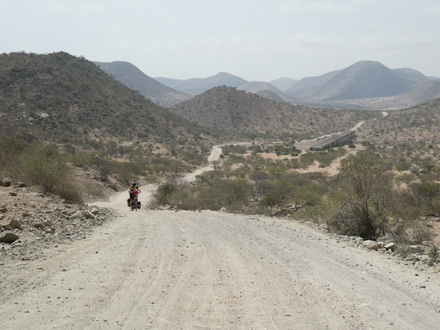

Entering a big town means cycling through a few kms of rubbish dumps, but the entrance into Namibe on the main drag was the worst on this trip. Otherwise, it was a great spot for the first shower after six days and a good feed or two. The colourful colonial buildings downtown set Namibe apart and it was a perfect choice for a rest day or two.


Well rested we left it, this time on a secondary road that offered more plastic-free views. Heading straight inland we had tailwind and an increasingly beautiful landscape. Eroded monoliths stood around glowing red in the afternoon sun while thorny trees and bushes, waiting to be turned into charcoal by the local tribesmen, gave shelter to an array of colourful birds.


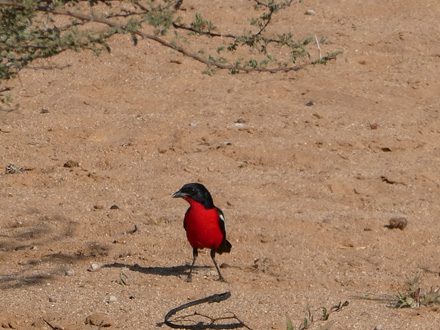
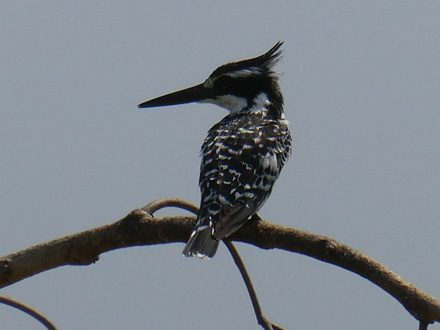
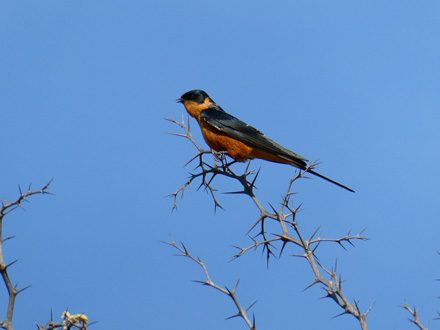

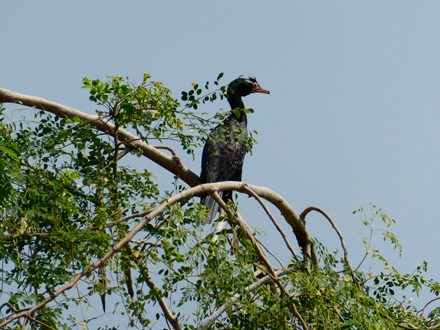
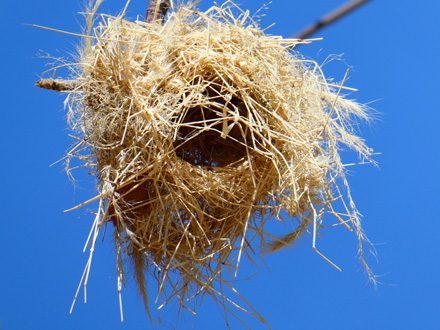
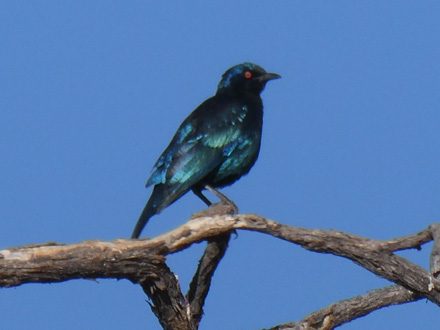
The absolute highlight was the climb up the Serra da Leba. Crawling up a 1,500m high wall in the midday heat was taxing, but we made it to the last few serpentines at the top of the cliff just in time for sunset.


Camping at the viewpoint restaurant was ideal, not least for the magnificent view the next morning. Rolling out of the tent to a sun-kissed sea of fog in the valley was absolute magic!

A little more climbing brought us to the sprawling Lubango, where it was time again to rest our legs. A guided tour of the regional ethnographic museum is fascinating, and we learned a lot about how the various tribes live.


We still had seven days left on our visa for the remaining 430kms to the Namibian border at Santa Clara. It’s a gentle downhill/flat stretch through savanna adorned with huge baobab trees and termite mounds.


There is an abundance of waterholes and we shared this relatively quiet stretch of road with mostly indigenous communities and cattle/goat herds. There were also a number of monuments and tanks from civil-war days. With temperatures reaching high into the thirties at midday, we were happy with a mid-day break of a couple of hours in the shade; the first time this was necessary in Angola.


The country is a campers’ dream and as time moved on, we got better at picking wild camping spots and mastering the logistics of food and water. Our evening spots ranged from cactus and quartz gardens to beaches and bushes and no one ever appeared to give us grief. As Darina was heading off for her daily download one morning, a muffled grunting sound came from behind and a huge chimpanzee bounded into the bushes just as startled as we were!


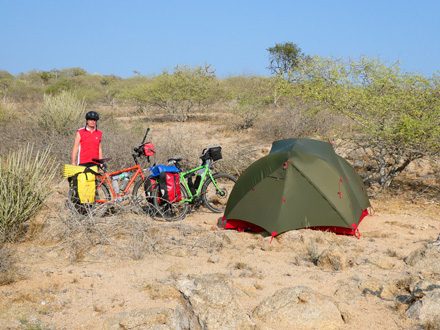
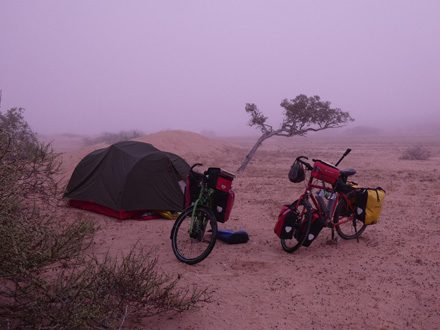
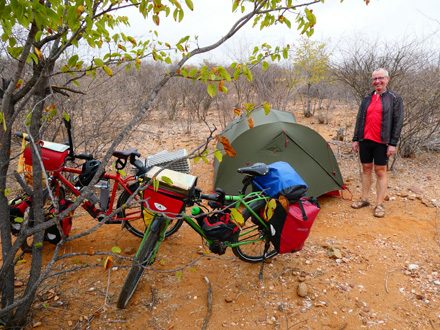
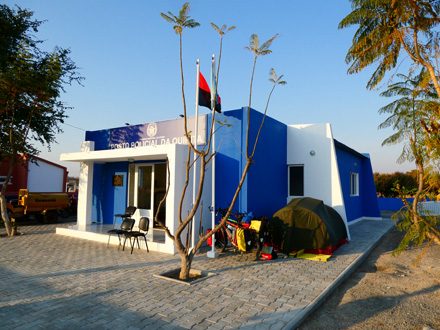
What makes Angola is its amazingly friendly, welcoming and honest people and three cheers for the Angolan truck drivers who were so accommodating of us cyclists on the road. Muito obrigado!
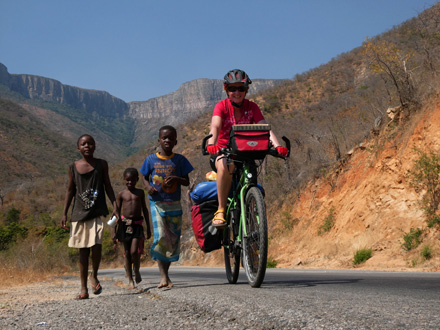


What we did notice is that Angola is a country where education is not encouraged or enforced unless your parents have enjoyed its benefits. The rest try to make ends meet by hawking on the roadside, and we would hazard a guess, that a huge percentage of the villagers go to sleep hungry.
The elections have since taken place and the ruling MPLA party won again – this time with 51% of the vote; the main opposition party UNITA trailing by 7%. It seems like handing out t-shirts and baseball caps did work after all. The opposition’s promises to improve health, education and the empowerment of women will just have to wait another five years.


We loved it when there were food stalls along the road. On the EN100, the choice varied between grilled meat/fish with fries, casseroles served with funge (maize porridge), hearty bean soups or dried wild meat like catapedra (above).
In restaurants, a typical dish was bitoque: steak topped off with a fried egg and served with rice, fries and a salad. Definitely fuel for a cyclist. Prices for main courses ranged from 2 to 15 Euros depending on location.


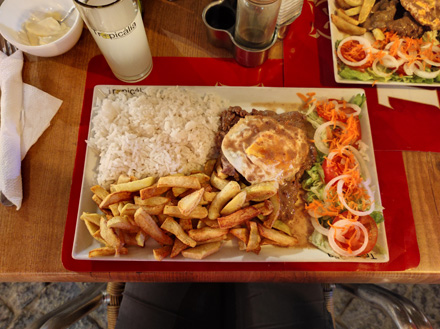
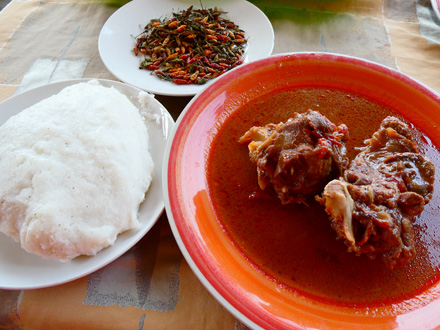
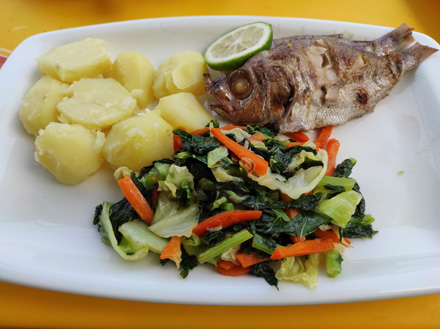
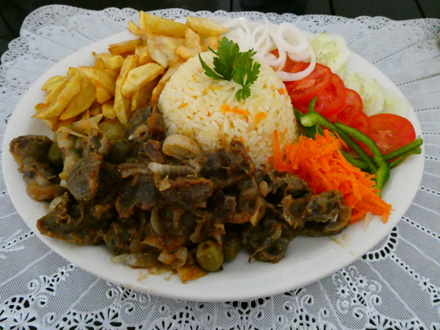
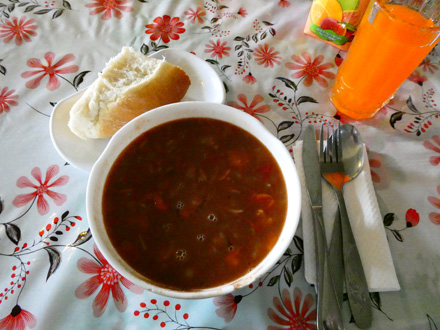
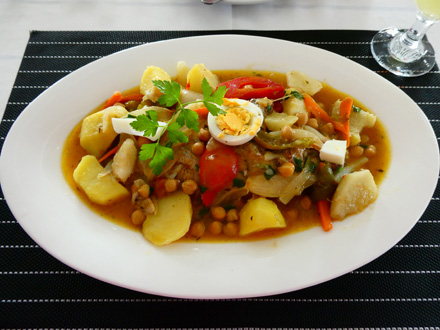
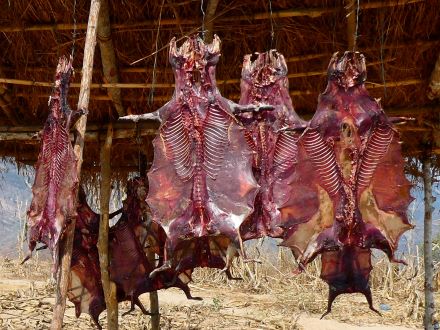
When we asked Luciano, our Couchsurfing host, to describe Angola, “undiscovered” was the word he chose. Now we can see exactly what he meant. International tourism is next to non-existent, but the country has amazing potential with its spectacular beach, mountain, savannah and desert scenery as well as its numerous rivers. Watch this space!





